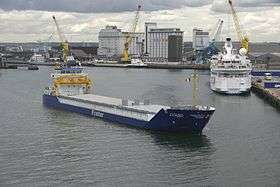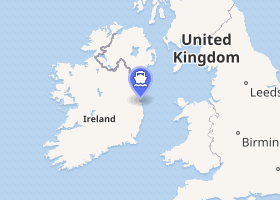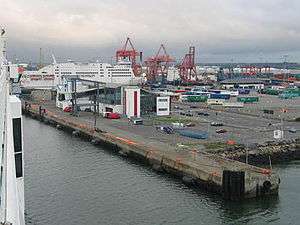Dublin Port
Dublin Port (Irish: Calafort Átha Cliath) is the seaport of Dublin, Ireland, of both historical and contemporary economic importance. Approximatively two-thirds of Ireland's port traffic travels via the port, which is by far the busiest on the island of Ireland. Recently, the port and its land, mostly at the eastern end of Dublin's Northside, but also with a southern section, were valued at €25 billion – €30 billion.
| Dublin Port | |
|---|---|
 Dublin Port – Western Basin | |

| |
| Location | |
| Country | Ireland |
| Coordinates | 53.34609°N 6.20831°W |
| UN/LOCODE | IEDUB[1] |
| Details | |
| Operated by | Dublin Port Company |
| Type of harbor | River port |
| Draft depth | depth 11.0 m.[2] |

Location
The modern Dublin Port is located either side of the River Liffey, out to its mouth. On the north side of the river, the main part (205 hectares or 510 acres) of the port lies at the end of East Wall and North Wall, from Alexandra Quay. The element of the port on the south side of the river is much smaller (51 hectares or 130 acres) and lies at the beginning of the Poolbeg peninsula.
Services
The main activity of the port is freight handling, with a wide range of vessels, from large container carriers to small diesel lighters, visiting daily.
Roll-on/roll-off passenger ferry services run regularly across the Irish Sea to Holyhead in Wales, Liverpool in England and in the summer months and at Christmas to Douglas, Isle of Man.[3] The largest car ferry in the world, the Irish Ferries ship MV Ulysses which can carry up to 2000 passengers, runs on the Holyhead route.
Dublin Port is also increasingly a docking point for cruise liners. Celebrity Eclipse began to home port in Dublin on 29 April 2018.[4] and the port authorities reported 217 cruise ship visits in 2017 and anticipated 251 visits 2018.[5] A temporary facility, Terminal 7, was created between Promenade and Tolka Quay Road at Branch Road; entered from Promenade Road, this allows cruise guests to check-in and leave baggage. A shuttle services transports guests to Ocean Pier 33. A new baggage claim facility was added to Ocean Pier 33 for guests to use when disembarking.
Dublin Port Company

The port is operated by the semi-state Dublin Port Company, incorporated on 28 February 1997 (formerly the Dublin Port and Docks Board, and successor to the Ballast Board founded in 1707), the headquarters of which are located just beyond the main port entrance on the northern side of the Liffey.
According to the DPC, the port handled 23.5 million tonnes of cargo in 2003, as well as 1,426,000 passengers. That year 7,917 ships docked in the port, including 54 cruise liners carrying 54,000 visitors. In April 2010, the Dublin Port Company announced its "busiest week ever", following restrictions placed on European airspace because of the eruption of the Eyjafjallajökull volcano in Iceland. Some 72,118 passengers were reported to have travelled through the ferry terminals during the week 15–21 April. That week saw the culmination of increased trade in Dublin Port, as the company's figures for the first quarter of 2010 would eventually reveal. March 2010 saw a 13.5% trade increase when compared with March 2009, and that month was declared by the company as the fourth consecutive month of trade increase[6] since the economic downturn.
The Port Company is responsible for pilotage services within Dublin Bay, and manages the three port lighthouses (but not those of Howth or Kish Bank). It also operates three diesel tugboats and two drydocks (located near Alexandra Quay) and provides divers for underwater hull inspections. It licences private companies to provide stevedoring services.
Other activities
Within the main port enclave, on the north side of the river, are a power generating station (gas-fired), several oil terminals and number of slightly-related businesses, such as car dealerships, and a Topaz fuelling station on Bond Road. Entered at the north side of the port, but lying in East Wall, is one end of the Dublin Port Tunnel.
History
The medieval port of Dublin was located on the south bank of the Liffey near Christ Church Cathedral, a few miles upstream from its current location. In 1715, the Great South Wall was constructed to shelter the entrance to the port. Poolbeg Lighthouse at the end of the South Bull Wall was constructed in 1767.
In 1800, a survey of Dublin Bay conducted by Captain William Bligh recommended the construction of the Bull Wall. After the completion of the wall in 1842, North Bull Island slowly formed as sand built up behind it.[7]
After James Gandon's Custom House was built further downstream in 1791, the port moved downstream to the north bank of the river estuary, where the International Financial Services Centre is currently located. The noise and dirt associated with the port traffic contributed to the decline of the formerly fashionable Mountjoy Square area, with many wealthy families moving to the Southside.
The advent of containerisation in the second half of the 20th century resulted in the port gradually moving a mile further downstream to enable new wharves to be constructed.
Future
A 2018 review of a 'Draft Masterplan 2040' was published by the Dublin Port Company. By 2023, the current Terminal 3 will be converted into Berth 18 for Cruise ships. This new facility will replace the temporary check-in facility at Terminal 7 on Tolka Quay Road and eliminate the need to shuttle guests to Ocean Pier 33. Public transportation options also will be improved.
Over many years, the Dublin Port authorities have been exploring a controversial proposal to in-fill 21 hectares (52 acres) of Dublin Bay – a continuation of historical practice, as all of the port land was once part of Dublin Bay. Residents on areas near the proposed in-fill, on the north side of the Liffey, are strongly opposed to the plan, which, as of 2018, has not progressed.

Terminals
Sources:[8]
Passenger
| Ferry Company | Destination | Terminal |
|---|---|---|
| Irish Ferries | Holyhead | 1 |
| Irish Ferries | Cherbourg | 1 |
| Isle of Man Steam Packet Company | Douglas, Isle of Man | 1 |
| Stena Line | Holyhead | 2 |
| P&O Ferries | Liverpool | 3 |
| Seatruck Ferries | Liverpool and Heysham | 5 |
Passenger Ferries
| Preceding station | Ferry | Following station | ||
|---|---|---|---|---|
| Terminus | Irish Ferries Ferry |
Holyhead | ||
| Cherbourg | ||||
| Terminus | Irish Ferries high-speed catamaran |
Holyhead | ||
| Terminus | Stena Line Ferry |
Holyhead | ||
| Terminus | Isle of Man Steam Packet Ferry (seasonal) |
Douglas |
Rail passenger access to and from Dublin Connolly
A connection from Dublin Connolly to Dublin Port can be reached by walking beside the tram lines around the corner from Amiens Street, Dublin into Store Street or by taking the Luas one stop to Busáras where Dublin Bus operates a service to the Ferry Terminal, or Dublin Bus route 53[9] or by taxi.
Freight
| Ferry Company | Destination | Terminal |
|---|---|---|
| BG Freight Line | Antwerp, Belfast, Liverpool, Rotterdam | MTL |
| Celtic Forwarding | Antwerp, Rotterdam | DFT |
| CMA CGM | Le Havre | MTL |
| Cobelfret | Rotterdam, Zeebrugge | CUCT |
| Eucon | Antwerp, Rotterdam, Rouen, Southampton | DFT |
| Samskip | Rotterdam, Zeebrugge | DFT |
| Zim Integrated Shipping Services | Rotterdam | DFT |
See also
References
- "UNLOCODE (IE) - IRELAND". service.unece.org. Retrieved 19 May 2020.
- "Port of Dublin, Ireland". www.findaport.com. Shipping Guides Ltd. Retrieved 19 May 2020.
- http://www.steam-packet.com
- https://www.independent.ie/life/travel/cruise/twice-the-length-of-croke-park-317m-cruise-ship-arrives-to-call-dublin-home-36853562.html
- http://www.dublinport.ie
- http://www.insideireland.ie/index.cfm/section/news/ext/dublinportcompany001/category/1062%5B%5D
- Woodworth, Paddy (19 July 2012). "Dublin's accidental island". The Irish Times. Retrieved 23 April 2019.
- "Information Centre. Retrieved 2 May 2011". Dublinport.com. Retrieved 2 May 2011.
- http://www.dublinbus.ie/en/Your-Journey1/Timetables/All-Timetables/53/
External links
| Wikimedia Commons has media related to Dublin Port. |